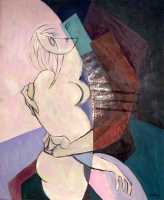WHAT DO YOU THINK OF
PICASSO?
La Dépêche Marocaine, Tanger, Morocco, February 1950
It is difficult today to speak of painting without soon hearing this
question posed.
 |
Embrace
I by Jean Tabaud
(See Artwork H-15) |
Picasso is a name like Nostradamus - mysterious but, at the same
time, familiar. Something like a cabal between reality and legend.
One speaks easily of the Garden of the Hespéridas or of the
fourth dimension without really knowing what they are. Picasso is
one of those subjects that leads to the discussion of a sphere of
activity, where, were it not for him, one would never have set foot.
However, even if one enters the arena of the art world with prejudice
and blindfolded, it is, nevertheless, a good beginning for the amateur.
One cannot understand Picasso simply by the outrageous creatures
he paints. Such as a figure with two eyes on the same side of the
head and a mixture of other body parts in the form of triangles, chopped
up polygons, stripes, and dislocated joints. Happily, the paintings
of Léonardo de Vinci, Rubens, Ingres, and babies in their cribs
reassure many that Picasso is crazy, and he is making fun of us.
One should remember that Picasso once painted in a purely classical
style. Vlaminck says that is precisely why we feel taken advantage
of. But Picasso's style has influenced a whole generation of painters.
This is a fact, whether it be accidental, a form of entertainment,
a mistake, or a hoax, it is a fact. And a fact is a fact. Therefore,
one must conclude that, for the sake of history, Picasso is a genuine
artist.
All painters and their works go through a maturing process, but it
is rare that it evolves in more than two stages. First comes youth
- the time of formation - then comes maturity when the forms and colors
of the artist stabilize.
Picasso knew how to cover a canvas with the luminous colors of the
French Impressionists, but his intense Spanish personality drove him
to finally express his real feelings (as demonstrated by his paintings
of harlequins, his pink, and then blue periods, etc.) And then finally
he reached a point where his spirit became like that of a child who
cuts his cardboard horse in half, or his puppets, in order to see
what's inside. All at once, he knew he had found the art form he was
searching for.
Picasso took apart figures and shapes looking for their skeletons,
probed, investigated, searched for the very essence of their beings,
then, like a child embarrassed by the mess he has made, puts them
back together (as he sees fit). For instance, he paints an ideal horse,
with only a piece of string for a bridle. Picasso creates his own
private world, enriched by his unalterable imagination.
Jean Tabaud

